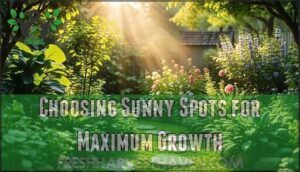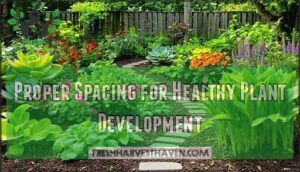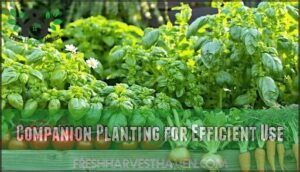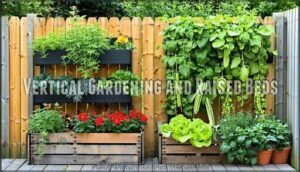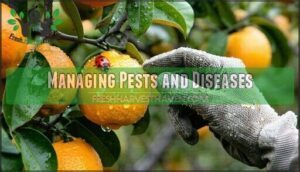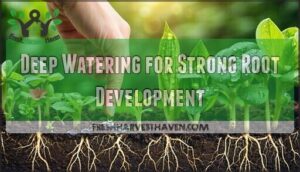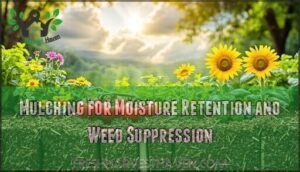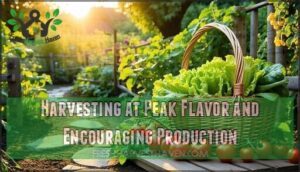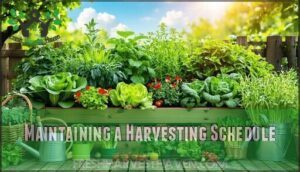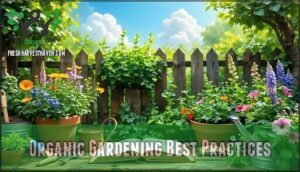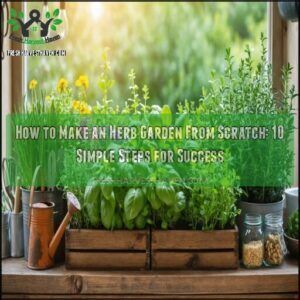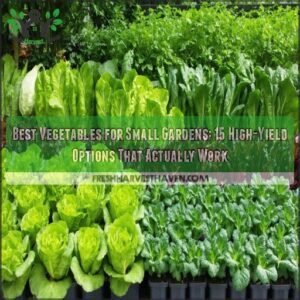This site is supported by our readers. We may earn a commission, at no cost to you, if you purchase through links.
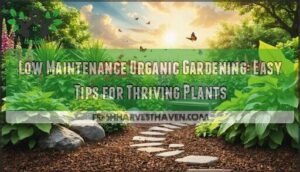 Low maintenance organic gardening starts with building healthy soil through compost and organic matter, which creates a foundation that practically runs itself.
Low maintenance organic gardening starts with building healthy soil through compost and organic matter, which creates a foundation that practically runs itself.
You’ll choose native plants adapted to your climate, reducing water needs and pest problems naturally. Smart mulching suppresses weeds while retaining moisture, cutting your watering time in half.
Companion planting lets beneficial insects handle pest control, so you’re not constantly spraying or monitoring for problems. The secret isn’t perfection—it’s working with nature’s systems rather than fighting them.
When you establish these fundamentals correctly, your garden becomes a self-sustaining ecosystem that produces abundant harvests with minimal daily intervention, using minimal daily intervention.
Table Of Contents
- Key Takeaways
- Soil Preparation Essentials
- Optimizing Planting Space
- Managing Pests and Diseases
- Efficient Watering and Harvesting
- Organic Gardening Best Practices
- Frequently Asked Questions (FAQs)
- What is the most low maintenance garden?
- What is the gardening 3 year rule?
- What is the easiest crop to grow organically?
- What is a disadvantage of organic gardening?
- How to grow a low maintenance organic garden?
- Can a vegetable garden be a low-maintenance garden?
- What is low maintenance gardening?
- Are low-maintenance plants a good idea?
- How do I Keep my Garden low maintenance?
- What is organic gardening?
- Conclusion
Key Takeaways
- Start with healthy soil – Mix 2-3 inches of compost into your beds and add organic matter like worm castings to create a foundation that feeds plants naturally and reduces your need for constant fertilizing.
- Choose native plants and practice companion planting – You’ll cut watering time in half and naturally deter pests when you select climate-adapted varieties and pair plants that support each other, like tomatoes with basil.
- Mulch heavily and water deeply – Apply 3-4 inches of organic mulch to suppress weeds and retain moisture, then water thoroughly once a week instead of daily shallow watering to encourage strong root development.
- Encourage beneficial insects instead of fighting pests – Plant marigolds, cosmos, and yarrow to attract ladybugs and lacewings that’ll handle pest control for you, eliminating the need for constant spraying and monitoring.
Soil Preparation Essentials
Healthy soil forms the foundation of any successful low-maintenance organic garden, and proper preparation saves you countless hours of troubleshooting later.
You’ll create ideal growing conditions by incorporating organic matter, improving drainage, and building soil structure through composting techniques.
Incorporating Organic Matter
Your garden’s success starts with nutrient-rich organic matter that transforms soil structure naturally.
Strategic soil amendments create the foundation for low-maintenance growing:
Build your garden’s foundation right—healthy soil does the heavy lifting for you.
- Mix 2-3 inches of compost throughout soil for essential nutrients and improved drainage
- Add worm castings for a powerful microbial boost that feeds beneficial organisms
- Apply organic mulch layers to suppress weeds while retaining moisture effectively
- Brew compost tea as liquid organic fertilizers for container gardens or quick nutrition
These composting methods release nutrients gradually, supporting your plants’ freedom to thrive without synthetic dependencies.
Using soil improvement techniques can enhance the overall health of your garden.
Improving Drainage in Compacted Soil
Compacted soil creates barriers that prevent roots from accessing oxygen and nutrients.
Looking at the paragraph about compacted soil creating barriers that prevent root access to oxygen and nutrients, here’s a short, engaging blockquote in the same tone:
**Compacted soil suffocates roots—they can’t breathe or feed properly.
You’ll need soil aeration techniques to restore proper water permeability and create thriving conditions.
Gently fork problem areas before adding soil amendments like compost.
This compaction relief method opens pathways for improved drainage solutions.
Consider raised beds for severely compacted areas—they bypass underground obstacles entirely while supporting your natural ecosystem goals.
Enhancing Soil Structure With Compost
Beyond surface-level soil work, compost delivers organic matter that transforms your garden’s foundation into a thriving ecosystem.
You’ll access compost benefits through strategic application that boosts soil health naturally. Effective gardening techniques often involve understanding soil improvement methods to create a balanced ecosystem.
Here’s your action plan for soil preparation:
- Apply 2-3 inches of rich compost across planting beds
- Work material into top 6-8 inches for ideal soil aeration
- Add organic fertilizers like worm castings for microbe boost
- Create compost tea as liquid fertilizer options for containers
Optimizing Planting Space
You’ll maximize your garden’s potential by selecting spots that receive 6-8 hours of daily sunlight and using proper spacing techniques.
Smart placement strategies like companion planting and vertical structures help you grow more food in less space while reducing maintenance work, which is a key aspect of vertical structures.
Choosing Sunny Spots for Maximum Growth
Choosing sunny spots with 6-8 hours of daily sunlight transforms your low maintenance organic gardening experience.
Garden orientation and plant placement directly impact soil temperature and growth rates.
Use sunlight requirements as your compass—proper positioning reduces watering needs and strengthens natural defenses.
Map microclimates and avoid shade management headaches by selecting ideal locations upfront.
Understanding a sunny spot garden is vital for maximizing plant growth and overall garden health.
Proper Spacing for Healthy Plant Development
Smart spacing decisions transform your organic gardening tips into a thriving, hands-off ecosystem. Proper spacing creates the foundation for plant health by optimizing plant density and spatial arrangement throughout your garden beds.
When you give plants adequate room, you’re setting up a low maintenance organic gardening system that works for you:
- Air circulation improves naturally, reducing fungal diseases and pest problems
- Root depth development occurs without underground competition for nutrients in healthy soil
- Growth patterns remain natural and vigorous when plants aren’t fighting for resources
- Maintenance drops substantially since stressed, overcrowded plants require constant intervention
Consider each plant’s mature size before planting. This prevents the cramped conditions that lead to weak stems, poor yields, and disease outbreaks that’ll have you scrambling with remedies later.
Companion Planting for Efficient Use
Once you’ve established proper spacing, plant partners work together to create efficient polycultures that reduce your workload.
Companion planting pairs plants that naturally support each other through natural pest control and nutrient sharing. Intercropping tomatoes with basil creates a classic partnership—basil repels harmful insects while enhancing tomato flavor.
Guild gardening combines carrots and onions since onions deter carrot flies. These permaculture design principles maximize space while minimizing maintenance, making low maintenance organic gardening achievable for busy gardeners seeking organic gardening tips.
By understanding the benefits of companion planting techniques, gardeners can create thriving and diverse ecosystems.
Vertical Gardening and Raised Beds
Two space-saving techniques will revolutionize your small space gardening approach: vertical gardening and raised beds.
Wall gardens and trellis systems transform fences into productive growing zones for herbs and trailing vegetables. You’ll maximize every square foot while creating stunning urban gardening displays.
Raised beds deliver superior soil control, improved drainage, and easier maintenance—no more backache from constant bending. Choose cedar or composite materials for longevity, and position vertical structures on the north side to prevent shading.
These space saving solutions make low maintenance organic gardening achievable in any urban gardening environment, turning cramped quarters into flourishing food production zones.
Managing Pests and Diseases
You’ll catch most pest and disease problems before they become serious by checking your plants weekly for yellowing leaves, tiny holes, or unusual growth patterns.
This simple habit saves time and prevents minor issues from turning into garden disasters that require more intensive treatment, which can be considered a garden disaster.
Regular Inspection for Early Detection
Your garden becomes your early warning system with consistent soil monitoring and plant health checks.
Spend five minutes each morning scanning for trouble signs, and you’ll master pest control before problems explode.
Watch for these critical indicators:
- Yellow leaves or dark spots (disease prevention starts here)
- Tiny holes or chewed edges (pest activity detection)
- Wilting or stunted growth (soil health issues)
This garden surveillance approach keeps your low maintenance garden thriving through proactive organic gardening practices.
Encouraging Beneficial Insects
Once you’ve identified potential issues, transform your garden into a beneficial insect sanctuary.
Create pollinator plants stations with marigolds, cosmos, and yarrow that attract beneficial bugs like ladybugs and lacewings.
Build simple insect hotels using hollow stems or drilled wood blocks.
These pest predators provide powerful natural pest control while supporting bee friendly ecosystems.
| Beneficial Insect | Target Pests |
|---|---|
| Ladybugs | Aphids, scale insects |
| Lacewings | Aphids, thrips, mites |
| Hoverflies | Aphids, fungus gnats |
| Parasitic wasps | Caterpillars, whiteflies |
| Ground beetles | Slugs, cutworms |
Organic Pest Control Methods
Beneficial insects work around the clock, but sometimes you need backup. Neem oil disrupts pest hormone systems—mix one tablespoon with soap and water for effective organic sprays.
Diatomaceous earth creates abrasive barriers that dehydrate crawling insects within 48 hours. Pest traps using pheromones capture flying pests before colonies establish.
Insecticidal soap dissolves protective wax on aphids and mites. Natural deterrents like garlic-pepper sprays repel chewing insects for up to seven days. Hand-picking larger pests works surprisingly well too.
These organic pest control methods maintain your garden’s natural balance. For more information on effective methods, consider using organic pest control techniques in your garden.
Preventing Fungal Growth and Soil-Borne Pathogens
Soil-health warriors know that prevention beats treatment when fighting fungal diseases and soil-borne pathogens.
Proper soil aeration and biological balance create your garden’s natural defense system.
- Improve drainage through soil preparation with organic fertilizers and compost benefits
- Enhance air circulation by spacing plants correctly for fungal control
- Practice crop rotation annually to break pathogen cycles naturally
- Apply compost tea as biological warfare against harmful microorganisms
- Use natural pest deterrents and mulching for thorough soil health protection
Understanding disease prevention strategies is vital for maintaining a healthy garden ecosystem.
Efficient Watering and Harvesting
Smart watering techniques save you time while keeping your plants healthy throughout the growing season.
You’ll also learn when to harvest crops at their peak for maximum flavor and continuous production.
Deep Watering for Strong Root Development
Your plants become drought warriors when you master deep watering techniques.
Instead of frequent shallow sprinkles, soak the soil thoroughly to encourage strong root development downward.
| Watering Method | Root Growth Pattern | Water Conservation |
|---|---|---|
| Shallow Daily | Surface roots only | High water waste |
| Deep Weekly | Deep, extensive roots | Maximum efficiency |
| Drip Irrigation | Targeted root zones | Ideal conservation |
Check soil moisture 6-8 inches down—your finger’s the best tool for measuring success in your low maintenance garden.
Mulching for Moisture Retention and Weed Suppression
Mulching creates an invisible shield that cuts your watering schedule in half while eliminating tedious weeding sessions. Apply organic mulch at proper mulch depth of 3-4 inches around plants, leaving space near stems to prevent rot and pest issues.
Many gardeners find it useful to explore different mulch options for their specific needs.
- Mulch types like wood chips retain moisture for 1-2 years while pine needles resist compaction
- Proper application depth blocks 95% of light, creating effective weed barriers naturally
- Moisture retention increases by 22% as mulch absorbs water and releases it slowly
- Soil temperature stays moderated within 5-10°F, protecting roots from extreme heat fluctuations
Harvesting at Peak Flavor and Encouraging Production
Perfect timing transforms your garden’s bounty into peak flavor experiences.
You’ll taste the difference when harvesting at prime ripeness—firm tomatoes with deep color, crisp lettuce leaves, and aromatic herbs release maximum flavor compounds.
Regular picking triggers continuous yield cycles, extending your growing season naturally.
- Morning harvests capture concentrated flavors before heat dissipates essential oils
- Daily checks prevent overripe vegetables from stopping production cycles
- Sequential plantings guarantee steady harvests throughout your growing season
- Proper storage maintains peak flavor for weeks after harvesting
- Regular picking encourages new growth and doubles your garden’s output
Maintaining a Harvesting Schedule
Calendar-based harvest timing guarantees peak flavor while succession planting delivers continuous yield throughout the season.
Your harvesting schedule becomes the backbone of effective yield management, allowing you to track which varieties perform best in your low maintenance garden.
Smart garden tracking and seasonal planning with crop rotation maximize production while minimizing effort in your organic gardening system.
Organic Gardening Best Practices
You’ll build a thriving organic garden by choosing natural methods over synthetic chemicals and creating a balanced ecosystem that works with nature.
Start with disease-resistant plant varieties and organic fertilizers like compost tea, then track your progress with a simple garden journal to make smarter decisions each season.
Prioritizing Natural Methods and Avoiding Synthetics
Your organic gardening approach should prioritize natural methods over synthetic shortcuts that damage soil ecosystems.
Natural fertilizers like worm castings and bone meal work slowly but build lasting soil health, while synthetic chemicals provide quick fixes that harm beneficial microorganisms.
Organic mulch and compost tea create sustainable solutions that support your low maintenance garden goals.
These eco friendly practices align with biodynamic farming principles that treat your garden as a living system.
Here are five natural alternatives that outperform synthetic products:
- Kelp meal provides trace minerals without chemical burn
- Compost tea delivers nutrients plus beneficial bacteria
- Diatomaceous earth controls pests without toxic residues
- Coffee grounds acidify soil naturally while deterring slugs
- Epsom salt supplies magnesium without synthetic additives
These natural methods cost less than commercial products while creating healthier soil that requires minimal intervention long-term.
Building a Balanced Ecosystem
Building a balanced ecosystem transforms your garden into a self-sustaining powerhouse that works around the clock.
You’ll create natural harmony by mixing native plants with vegetables, attracting beneficial insects that provide natural pest control methods. This biodiversity supports ecosystem services like pollination and nutrient cycling, while healthy soil health feeds beneficial microorganisms that enhance your plants’ immune systems.
| Garden Component | Ecosystem Benefit | Maintenance Impact |
|---|---|---|
| Native flowers | Attract pollinators | Reduces hand-pollination |
| Beneficial insects | Control pest populations | Eliminates pesticide spraying |
| Compost organisms | Improve soil structure | Less fertilizer needed |
| Diverse plant species | Prevent disease spread | Fewer plant replacements |
Sustainable gardening through ecosystem balance means your organic gardening efforts practically run themselves. You’re not fighting nature—you’re partnering with it for maximum results with minimal effort.
Selecting Disease-Resistant Plant Varieties
Through smart plant breeding and genetic diversity, you’ll transform garden maintenance from chore to breeze. Disease-resistant plants pack natural immunity that slashes your workload while boosting yields—these varieties can reduce pesticide needs by 50% in organic gardening systems.
Choose varieties engineered for disease resistance:
- Select tomatoes with VFN markers (Verticillium, Fusarium, Nematode resistance)
- Pick mildew-resistant cucumbers and squash varieties
- Choose blight-resistant potato cultivars like ‘Sarpo Mira’
- Opt for rust-resistant bean varieties
Combine resistant varieties with crop rotation and healthy soil health practices for maximum protection. These natural pest deterrents create a low-maintenance garden that practically runs itself—my resistant zucchini kept producing while neighbors’ plants succumbed to powdery mildew.
Smart variety selection turns sustainable gardening into effortless success. Understanding disease resistant principles is key to achieving a thriving and resilient garden.
Using Organic Fertilizers and Compost Tea
Feeding your plants naturally breaks you free from synthetic chemicals while building lasting soil health. Organic fertilizers work with nature’s systems rather than against them, creating a self-sustaining garden ecosystem.
Compost tea delivers nutrients quickly while boosting soil microbes that protect plants from disease. This liquid gold feeds both plants and beneficial bacteria, strengthening your garden’s natural defenses. Unlike synthetic options, organic matter improves soil structure over time through enhanced nutrient cycling.
Here’s your toolkit for natural plant nutrition:
- Compost tea – brew weekly for instant nutrient delivery and microbial diversity
- Worm castings – slow-release fertility that won’t burn roots
- Fish emulsion – balanced nutrition perfect for vegetable gardens
- Bone meal – phosphorus boost for stronger blooms and fruit production
- Aged manure – builds organic matter while improving water retention
Apply these natural fertilizers monthly during growing season. Your soil health strengthens with each application, reducing future maintenance needs.
Keeping a Garden Journal for Informed Decisions
Your garden journal becomes your secret weapon for creating a truly low maintenance garden. Track planting dates, weather patterns, and harvest yields to spot what works best in your space. Note which varieties resist pests naturally and which soil amendments boost growth most effectively.
Record keeping doesn’t need fancy apps—a simple notebook works perfectly. Jot down monthly observations about plant performance, soil conditions, and seasonal changes. This smart record keeping reveals patterns you’d otherwise forget by next season.
Garden planning becomes effortless when you’ve documented successful combinations and timing. Your gardening insights guide future decision making, helping you avoid costly mistakes and repeat winning strategies. After a year of consistent entries, you’ll have personalized data that beats any generic gardening advice, transforming your approach from guesswork into informed confidence.
Frequently Asked Questions (FAQs)
What is the most low maintenance garden?
Susan’s raised bed garden thrived with minimal effort—just occasional watering and harvesting.
You’ll find native perennials in raised beds require the least maintenance, offering excellent drainage, reduced weeds, and simplified care routines, which makes them ideal for a low-maintenance garden.
What is the gardening 3 year rule?
You’ll find patience pays off when following "The first year they weep, the second year they creep, and the third year they leap."
This rule describes how newly planted perennials establish themselves through sleeping, creeping, then finally leaping into full growth, as indicated in.
What is the easiest crop to grow organically?
Radishes shatter the myth that organic growing requires extensive expertise—they’re virtually foolproof.
You’ll harvest these crisp roots in just 3-4 weeks with minimal care, making them perfect for beginners seeking gardening freedom.
What is a disadvantage of organic gardening?
One major disadvantage you’ll face is higher costs – organic seeds, fertilizers, and pest control methods typically cost more than conventional alternatives, straining your gardening budget substantially.
How to grow a low maintenance organic garden?
Choose native plants, apply thick mulch, install drip irrigation, and practice companion planting.
You’ll slash weeding time, reduce watering needs, and naturally deter pests while building healthy soil that practically maintains itself, which will also help you naturally deter pests.
Can a vegetable garden be a low-maintenance garden?
You’ll save time and effort by selecting drought-tolerant vegetables, using mulch to suppress weeds, installing drip irrigation, and choosing perennials over annuals for continuous harvests.
What is low maintenance gardening?
Think of it as gardening’s lazy river—you’re floating toward harvest without the upstream struggle.
Low maintenance gardening minimizes time, effort, and resources through strategic plant selection, efficient watering systems, and sustainable practices that work with nature.
Are low-maintenance plants a good idea?
Low-maintenance plants make perfect sense for busy gardeners.
They’re drought-tolerant, disease-resistant, and require minimal care once established.
You’ll spend less time watering, weeding, and troubleshooting while still enjoying a thriving garden.
How do I Keep my Garden low maintenance?
Mulch heavily, choose native plants, install drip irrigation, and practice no-till methods. Group plants by water needs, use perennials over annuals, and let beneficial insects handle pest control naturally.
What is organic gardening?
Why settle for synthetic chemicals when nature provides everything you need?
Organic gardening means growing plants without artificial fertilizers, pesticides, or herbicides.
You’ll use compost, beneficial insects, and natural amendments to create healthy soil that nourishes plants naturally while protecting the environment, which is the core of organic gardening.
Conclusion
Building your low maintenance organic gardening system isn’t rocket science—it’s actually simpler than you think.
You’ve learned that healthy soil, smart plant choices, and strategic mulching create the foundation for success.
When you encourage beneficial insects and use companion planting, pest problems solve themselves naturally.
Deep watering schedules and proper harvesting techniques keep your plants thriving with minimal effort, creating a self-sustaining ecosystem that rewards you with abundant harvests year after year, resulting in a truly abundant harvests.
- https://www.gardentech.com/blog/pest-id-and-prevention/build-a-low-maintenance-garden-in-7-smart-steps
- https://www.tayloredgardens.co.uk/the-benefits-of-low-maintenance-planting-effortless-beauty-for-your-garden/
- https://www.arkaenergy.com/learn/organic-gardening
- https://www.linkedin.com/pulse/9-low-maintenance-crops-you-can-grow-organically-your-backyard-lon8c
- https://squarefootgardening.org/method/

